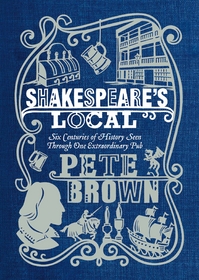By George -- the story of the London coaching inn that won't lie down
Added: Thursday, November 8th 2012
Pubs, inns and taverns are so deeply rooted in Britain’s history and culture that they have often featured in books and films as a backdrop to the dramas being enacted on the printed page or the screen. But it’s rare for an entire book to be written about a pub itself, for the good reason that most of them were built relatively recently and their stories would occupy only a few pages.
But one London inn has been standing – and falling down – for so many centuries that Pete Brown has filled more than 350 pages with its engrossing story. His book, Shakespeare’s Local (Macmillan, £16.99), is the tale of the George. The inn is tucked away down an alley off Borough High Street and is easy to miss.
But turn off the bustle of the main road and you feel you’re walking back through time as you enter a building rich in chronicles of derring-do and low cunning, ghosts, landlords, boozers and larger-than-life characters.
The London Bridge area is a vibrant place today. Across the road from the George you’ll find Borough Market, with its stalls and shops selling fresh food and drink. There’s a clutch of restaurants and pubs, the wine centre Vinopolis, Southwark Cathedral for the godly and the recreation of Shakespeare’s Globe Theatre for lovers of the Bard.
But the Borough has been a hive of activity for centuries. We’re used to a transport system that links all parts of the capital and it’s difficult to appreciate that London was once a sprawl of poorly connected boroughs. Southwark was cut off from the northern part of the city until the Thames was crossed by bridges. As a result, Borough High Street became the starting point for stage coaches that thundered down through Kent to the Channel ports with passengers and goods.
Great coaching inns sprang up to provide food, drink and accommodation for travellers. The George was not alone. There were eight coaching inns packed into the Borough. They included the Tabard, where Chaucer’s pilgrims set off for Canterbury in the 14th century, and the White Hart where in the 19th Charles Dickens’ Mr Pickwick made the acquaintance of Sam Weller.

Only the George remains. The coming of the railway in the 19th century, with London Bridge Station cheek-by-jowl with Borough High Street, spelt the end of stage coaches and their inns. The George, therefore, is a fascinating artefact that allows us to reach out and touch a period of our history that would otherwise be confined to scholarly books. Pete Brown conjures up from the George, with its small, low-ceilinged rooms, lattice windows, bare-boarded floors and wooden settles, a story of the inn that throbs with life. Thanks to his writing skill, you can smell the pungent ale and the hearty dishes served down the years, along with the less pleasant odours from the Thames and streets that were running sewers.
The George is named after England’s patron saint and was known as St George’s Inn until Henry VIII put an end to all signs of popery. In common with the other inns and buildings in the Borough, it burnt to the ground during the Great Fire of 1666 and was rebuilt a year later. Today, it’s the last galleried Elizabethan inn in London. The galleries were important as they allowed guests to reach their accommodation and also – with the courtyard below --to rehearse new plays by Shakespeare and other writers based at the Globe across the road.
With its warren of rooms, the George has always seemed a large pub to me but I learn from Pete that it’s only a small part of what was once a far larger building. In the 19th century, the owners sold a substantial part of the inn and its land to Guy’s Hospital, which was keen to expand its facilities. A quarter of a century later, the Great Northern Railway Company bought the site from Guy’s and turned most of the pub and grounds into warehouses.
Fortunately the George fell into safer hands in the 20th century. In 1937, the railway company couldn’t afford the upkeep of the site and donated it to the National Trust. It’s now a listed building and has been run by a succession of brewers for the trust: Flowers of Stratford-upon-Avon, followed by Whitbread and today Greene King.
Other brewers were once active in the area and they play a significant part in Pete’s book. By the banks of the Thames there were two might breweries, Thrale’s – which occupied the site of the original Globe Theatre – and Courage. The Thrales allowed the lexicographer Dr Samuel Johnson to work in rooms at the brewery and he ate and drank regularly in the George. Thrales became Barclay Perkins, which grew into the biggest brewery in London and was famous for its Russian Imperial Stout.
Shakespeare’s Local is packed with these and many other stories that will delight lovers of good beer and good pubs. It’s a rollicking good read.








